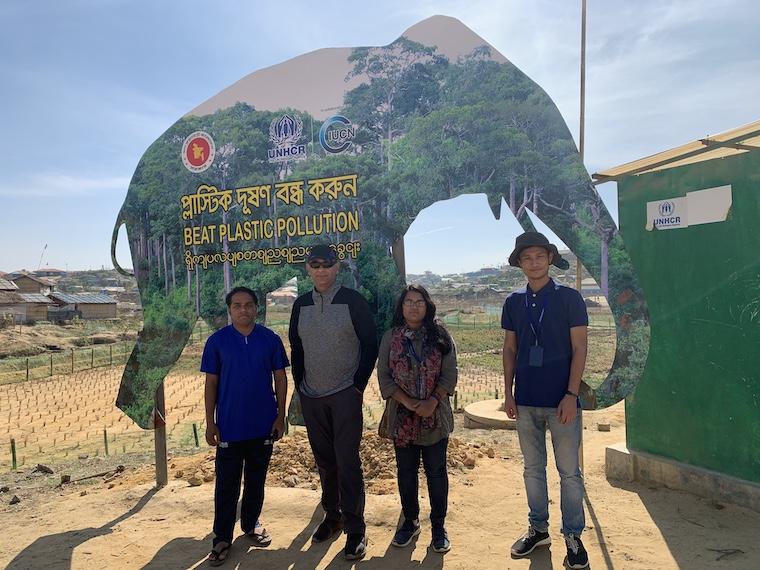Rumi Shammin Researching Rohingya Refugee Crisis in Bangladesh
June 28, 2019
Erin Ulrich ’18

When Associate Professor of Environmental Studies Rumi Shammin began his current research on the environmental and social dimensions of the Rohingya refugee crisis in Bangladesh, he had been researching community-based climate change adaptation initiatives in rural areas of the country for nearly a decade.
Through a Luce Initiative on Asian Studies and the Environment (LIASE) grant, Shammin visited the Kutupalong-Balukhali expansion site in the Cox’s Bazar district in January 2019, which is the largest refugee camp in the world with a population of more than 700,000 people.
“Once I visited the refugee camps, it opened up a new set of questions and opportunities to do further work,” Shammin says. “It was a transformative experience for me. I felt like I can actually contribute and get involved with work in these areas that will make meaningful differences in people’s lives today, unlike many of my other projects that have impact and results in the future.”
Shammin’s visit to the Kutupalong site came shortly after the third major Rohingya refugee crisis in 2017, which was prompted by clashes between a Rohingya rebel group and the Myanmar Army. Since the first Rohingya refugee crisis in 1977, large numbers of Rohingya Muslims have fled from Myanmar to neighboring Bangladesh. A 1982 citizenship law that left the Rohingya stateless, as well as their exclusion from Myanmar’s first democratic election in 2015, have contributed to the exponential surge of refugees in Bangladesh in recent years.
Shammin, whose primary scholarship areas are energy and urban issues, climate change adaptation mitigation, and sustainability and resilience, is now developing a new project on environmental sustainability and resilience in refugee settlements. He is examining the impact of the settlements on the environment, including energy and water usage, waste and wildlife management, as well as ecological restoration, protection, and rehabilitation. Shammin is particularly interested in the intersections of environmental, social, and public health issues in the camps.
“Even though I didn’t work specifically on refugee environmental issues, I did other work that’s similar,” he says. “So, I could transfer my experiences and skillset to this quite easily.”
Shammin’s ultimate goal is to develop a resilience framework for refugee response, which would provide guidelines that can be incorporated in refugee response programs around the world. Such a blueprint would address refugee environmental management, as well as social and mental health issues within the camps.

Photo credit: Rumi Shammin
In order to gain a more comprehensive understanding of opportunities to address these issues within refugee camps, Shammin is studying other major refugee settlements and seeking ways to identify isolated initiatives and replicate them on a wider scale.
Shammin says that developing such a blueprint may provide some relief for the millions of refugees throughout the world who experience trauma and uncertainty. Part of this model might include allowing refugees, especially young adults who may be especially affected by a lack of purpose, to play an active role in sustainability initiatives within the settlements. Such initiatives may include plantation and solar installation projects that could provide refugees with vocational training that might be helpful for future life beyond the camp.
“These approaches are places where you can see mental health and lack of purpose being addressed through empowerment and job and skills training,” Shammin says. “These programs can offer the refugees opportunities to be productive and at the same time advance environmental management of the settlements. That’s an example of where my work might be going: looking at ways to integrate environmental solutions with social solutions, so you have a more comprehensive approach.”
Shammin worked with three research assistants in spring 2019—Ananya Gupta ’20, Leo Lasdun ’20, and Charlotte Price ’20—who have supported his research on refugees. Gupta, an environmental studies major, focused on how organizations define refugees and how this affects those who don’t fit into such definitions.
“One of the best parts of this research is that our secondary research will hopefully contribute to professor Shammin’s primary research project on the refugee crisis in Bangladesh,” Gupta says. “Student work could potentially provide insight into the response available in situations of refugee crises across the world in the future, and that blows my mind every time I think about it.”
Price, who is also an environmental studies major, studied social and environmental programs with a particular focus on creative new approaches in selected refugee camps, including Zaatari in Jordan, Bidi Bidi in Uganda, and Dadaab and Kakuma in Kenya. Lasdun, an environmental studies and economics double major, worked on collecting and analyzing data on global refugee movements, categorizing the origins, drivers, and destinations of displaced people.
Shammin is currently working on a book titled Refugees and Resilience with Raquibul Amin of the International Union of Nature and Natural Resources (IUCN) and Dr. A.K. Enamul Haque of East West University in Bangladesh. He is also serving as an advisor to a group that is preparing refugee environmental management protocols for the Rohingya refugee camps.
Tags:
You may also like…
Peter Takács—A Half-Century Celebrated
May 4, 2024
This spring marks the official conclusion of Takács’ tenure, after an incredible 48 years of teaching. Many of his former students from around the world are set to convene for a celebratory concert in Warner Concert Hall on May 12
Oberlin Presents Grammy-Winning Imani Winds in Concert
February 28, 2024
When flutist Brandon Patrick George ’08 attended Imani Winds’ Artist Recital Series performance back in 2007, he never imagined that he would one day sit in the flute chair. “Being...
David Byrd-Marrow Appointed Horn Faculty at Oberlin Conservatory
February 7, 2024
Versatile American horn player David Byrd-Marrow has been appointed to the tenure-track horn professor position at Oberlin Conservatory. He brings an expansive range of experience and repertoire to the role.


